MGT8022 Project-Based Management Assignment 2: Memorandum Report
VerifiedAdded on 2023/04/03
|15
|3468
|414
Report
AI Summary
This memorandum, prepared by a student for their MGT8022 Project-Based Management assignment at the University of Southern Queensland, addresses a senior executive's request for advice on project management strategies. It begins by outlining the organizational context and then delves into a comparative analysis of Agile and Waterfall methodologies, highlighting their respective strengths and weaknesses. The memorandum then explores the structure of project governance, emphasizing the importance of defined roles, clear communication, and a culture of continuous learning. It also discusses the role and usage of Project Management Offices (PMOs), including the evolution from controlling to consultative approaches, and the significance of aligning PMOs with business goals. Finally, the memorandum touches upon the framework of Project Management Maturity, stressing the importance of process and methodologies, knowledge management, and senior-level buy-in for project success. The memo provides a comprehensive overview of key project management concepts, offering valuable insights for effective project execution and organizational strategy. The memorandum is a response to a conference attended by senior management, and presents recommendations for the business to consider.

Running head: MEMORANDUM FOR PROJECT-BASED MANAGEMENT
Memorandum for project-based management
Name of the student:
Name of the university:
Author Note
Memorandum for project-based management
Name of the student:
Name of the university:
Author Note
Paraphrase This Document
Need a fresh take? Get an instant paraphrase of this document with our AI Paraphraser
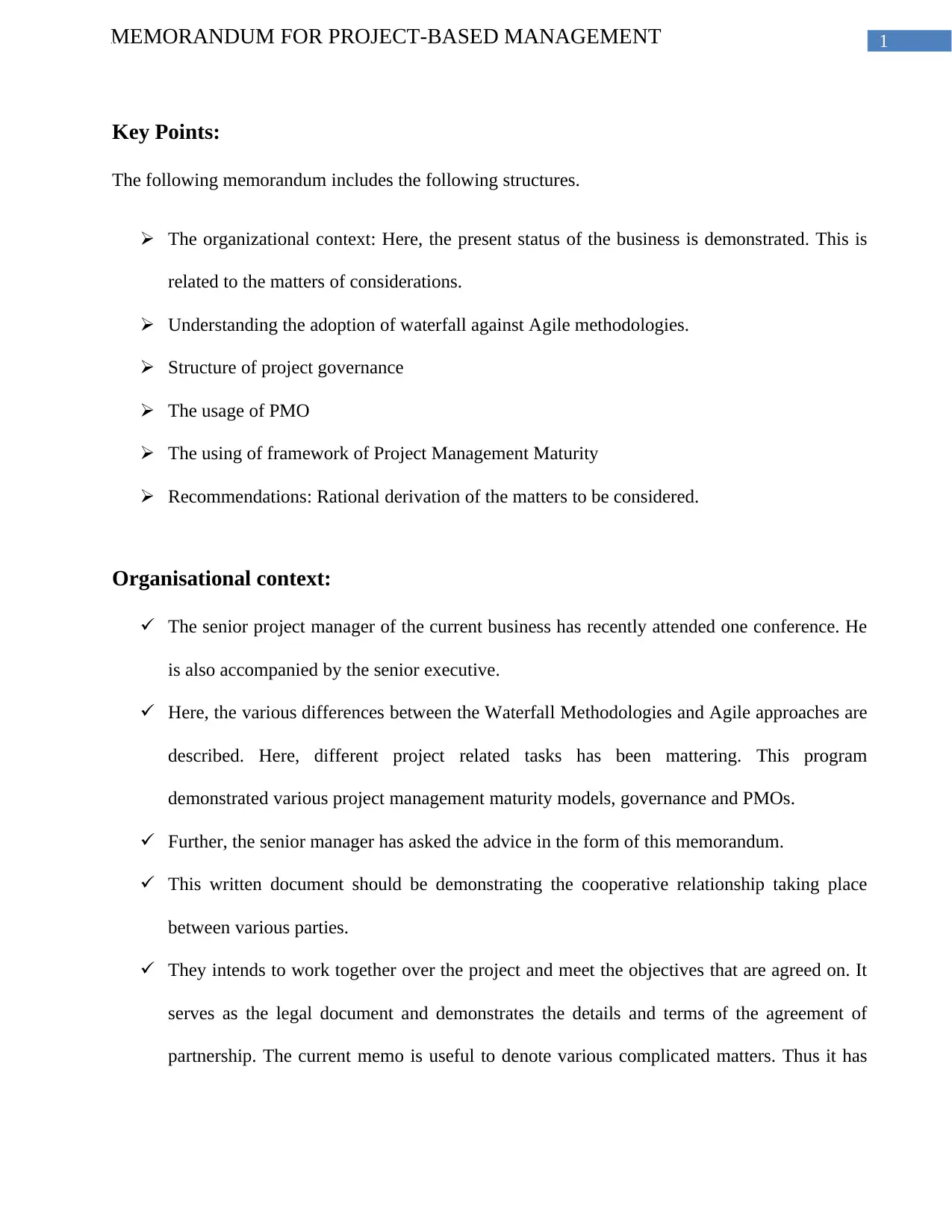
1MEMORANDUM FOR PROJECT-BASED MANAGEMENT
Key Points:
The following memorandum includes the following structures.
The organizational context: Here, the present status of the business is demonstrated. This is
related to the matters of considerations.
Understanding the adoption of waterfall against Agile methodologies.
Structure of project governance
The usage of PMO
The using of framework of Project Management Maturity
Recommendations: Rational derivation of the matters to be considered.
Organisational context:
The senior project manager of the current business has recently attended one conference. He
is also accompanied by the senior executive.
Here, the various differences between the Waterfall Methodologies and Agile approaches are
described. Here, different project related tasks has been mattering. This program
demonstrated various project management maturity models, governance and PMOs.
Further, the senior manager has asked the advice in the form of this memorandum.
This written document should be demonstrating the cooperative relationship taking place
between various parties.
They intends to work together over the project and meet the objectives that are agreed on. It
serves as the legal document and demonstrates the details and terms of the agreement of
partnership. The current memo is useful to denote various complicated matters. Thus it has
Key Points:
The following memorandum includes the following structures.
The organizational context: Here, the present status of the business is demonstrated. This is
related to the matters of considerations.
Understanding the adoption of waterfall against Agile methodologies.
Structure of project governance
The usage of PMO
The using of framework of Project Management Maturity
Recommendations: Rational derivation of the matters to be considered.
Organisational context:
The senior project manager of the current business has recently attended one conference. He
is also accompanied by the senior executive.
Here, the various differences between the Waterfall Methodologies and Agile approaches are
described. Here, different project related tasks has been mattering. This program
demonstrated various project management maturity models, governance and PMOs.
Further, the senior manager has asked the advice in the form of this memorandum.
This written document should be demonstrating the cooperative relationship taking place
between various parties.
They intends to work together over the project and meet the objectives that are agreed on. It
serves as the legal document and demonstrates the details and terms of the agreement of
partnership. The current memo is useful to denote various complicated matters. Thus it has
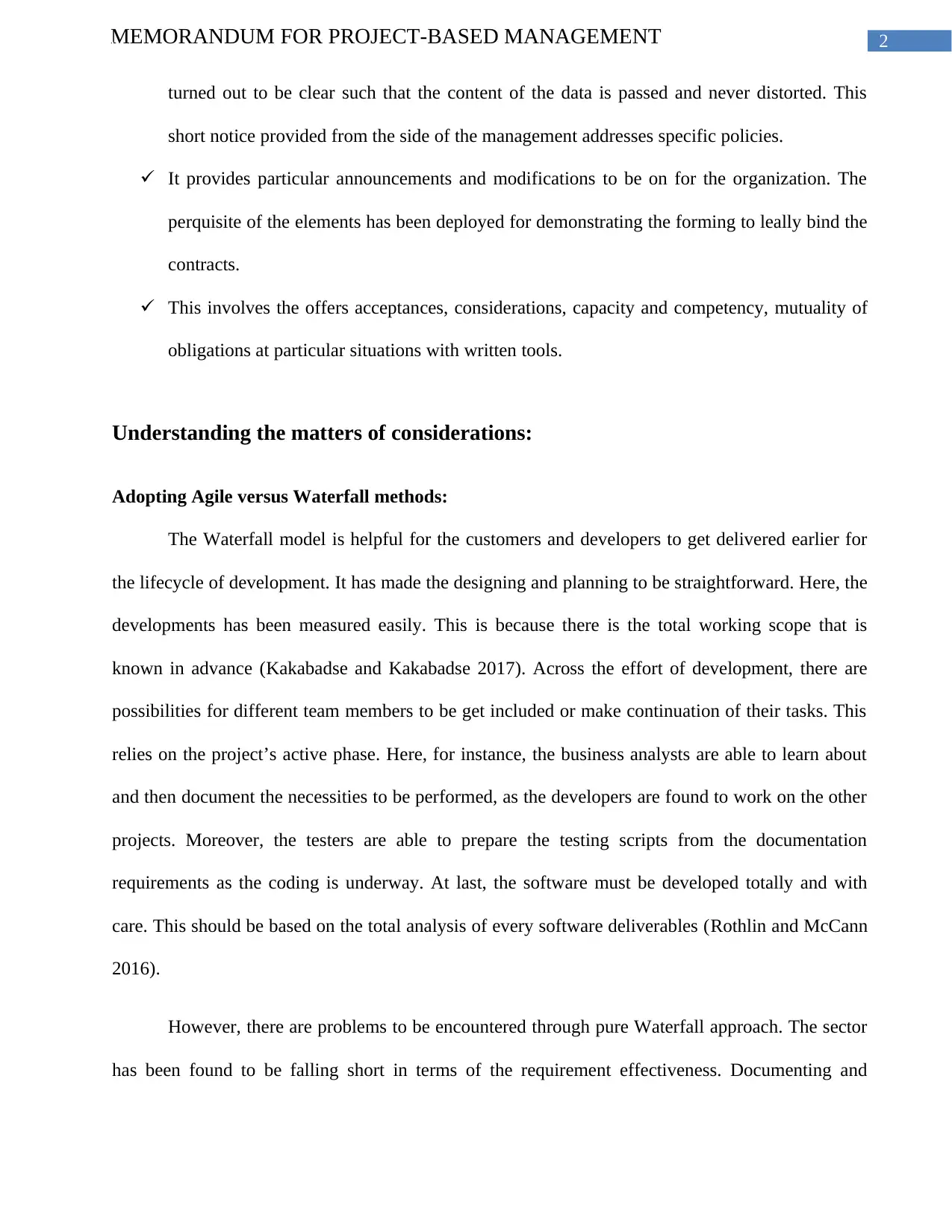
2MEMORANDUM FOR PROJECT-BASED MANAGEMENT
turned out to be clear such that the content of the data is passed and never distorted. This
short notice provided from the side of the management addresses specific policies.
It provides particular announcements and modifications to be on for the organization. The
perquisite of the elements has been deployed for demonstrating the forming to leally bind the
contracts.
This involves the offers acceptances, considerations, capacity and competency, mutuality of
obligations at particular situations with written tools.
Understanding the matters of considerations:
Adopting Agile versus Waterfall methods:
The Waterfall model is helpful for the customers and developers to get delivered earlier for
the lifecycle of development. It has made the designing and planning to be straightforward. Here, the
developments has been measured easily. This is because there is the total working scope that is
known in advance (Kakabadse and Kakabadse 2017). Across the effort of development, there are
possibilities for different team members to be get included or make continuation of their tasks. This
relies on the project’s active phase. Here, for instance, the business analysts are able to learn about
and then document the necessities to be performed, as the developers are found to work on the other
projects. Moreover, the testers are able to prepare the testing scripts from the documentation
requirements as the coding is underway. At last, the software must be developed totally and with
care. This should be based on the total analysis of every software deliverables (Rothlin and McCann
2016).
However, there are problems to be encountered through pure Waterfall approach. The sector
has been found to be falling short in terms of the requirement effectiveness. Documenting and
turned out to be clear such that the content of the data is passed and never distorted. This
short notice provided from the side of the management addresses specific policies.
It provides particular announcements and modifications to be on for the organization. The
perquisite of the elements has been deployed for demonstrating the forming to leally bind the
contracts.
This involves the offers acceptances, considerations, capacity and competency, mutuality of
obligations at particular situations with written tools.
Understanding the matters of considerations:
Adopting Agile versus Waterfall methods:
The Waterfall model is helpful for the customers and developers to get delivered earlier for
the lifecycle of development. It has made the designing and planning to be straightforward. Here, the
developments has been measured easily. This is because there is the total working scope that is
known in advance (Kakabadse and Kakabadse 2017). Across the effort of development, there are
possibilities for different team members to be get included or make continuation of their tasks. This
relies on the project’s active phase. Here, for instance, the business analysts are able to learn about
and then document the necessities to be performed, as the developers are found to work on the other
projects. Moreover, the testers are able to prepare the testing scripts from the documentation
requirements as the coding is underway. At last, the software must be developed totally and with
care. This should be based on the total analysis of every software deliverables (Rothlin and McCann
2016).
However, there are problems to be encountered through pure Waterfall approach. The sector
has been found to be falling short in terms of the requirement effectiveness. Documenting and
⊘ This is a preview!⊘
Do you want full access?
Subscribe today to unlock all pages.

Trusted by 1+ million students worldwide
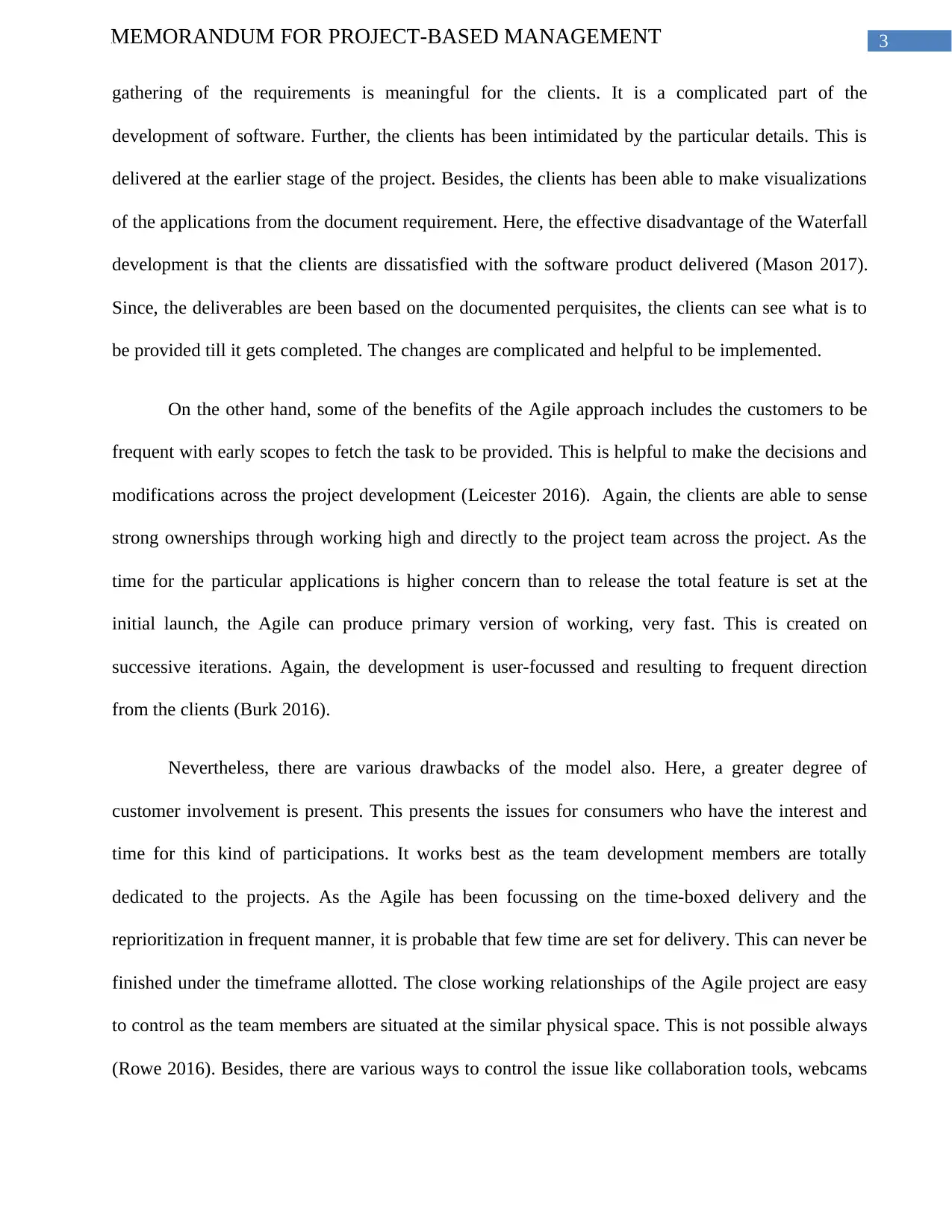
3MEMORANDUM FOR PROJECT-BASED MANAGEMENT
gathering of the requirements is meaningful for the clients. It is a complicated part of the
development of software. Further, the clients has been intimidated by the particular details. This is
delivered at the earlier stage of the project. Besides, the clients has been able to make visualizations
of the applications from the document requirement. Here, the effective disadvantage of the Waterfall
development is that the clients are dissatisfied with the software product delivered (Mason 2017).
Since, the deliverables are been based on the documented perquisites, the clients can see what is to
be provided till it gets completed. The changes are complicated and helpful to be implemented.
On the other hand, some of the benefits of the Agile approach includes the customers to be
frequent with early scopes to fetch the task to be provided. This is helpful to make the decisions and
modifications across the project development (Leicester 2016). Again, the clients are able to sense
strong ownerships through working high and directly to the project team across the project. As the
time for the particular applications is higher concern than to release the total feature is set at the
initial launch, the Agile can produce primary version of working, very fast. This is created on
successive iterations. Again, the development is user-focussed and resulting to frequent direction
from the clients (Burk 2016).
Nevertheless, there are various drawbacks of the model also. Here, a greater degree of
customer involvement is present. This presents the issues for consumers who have the interest and
time for this kind of participations. It works best as the team development members are totally
dedicated to the projects. As the Agile has been focussing on the time-boxed delivery and the
reprioritization in frequent manner, it is probable that few time are set for delivery. This can never be
finished under the timeframe allotted. The close working relationships of the Agile project are easy
to control as the team members are situated at the similar physical space. This is not possible always
(Rowe 2016). Besides, there are various ways to control the issue like collaboration tools, webcams
gathering of the requirements is meaningful for the clients. It is a complicated part of the
development of software. Further, the clients has been intimidated by the particular details. This is
delivered at the earlier stage of the project. Besides, the clients has been able to make visualizations
of the applications from the document requirement. Here, the effective disadvantage of the Waterfall
development is that the clients are dissatisfied with the software product delivered (Mason 2017).
Since, the deliverables are been based on the documented perquisites, the clients can see what is to
be provided till it gets completed. The changes are complicated and helpful to be implemented.
On the other hand, some of the benefits of the Agile approach includes the customers to be
frequent with early scopes to fetch the task to be provided. This is helpful to make the decisions and
modifications across the project development (Leicester 2016). Again, the clients are able to sense
strong ownerships through working high and directly to the project team across the project. As the
time for the particular applications is higher concern than to release the total feature is set at the
initial launch, the Agile can produce primary version of working, very fast. This is created on
successive iterations. Again, the development is user-focussed and resulting to frequent direction
from the clients (Burk 2016).
Nevertheless, there are various drawbacks of the model also. Here, a greater degree of
customer involvement is present. This presents the issues for consumers who have the interest and
time for this kind of participations. It works best as the team development members are totally
dedicated to the projects. As the Agile has been focussing on the time-boxed delivery and the
reprioritization in frequent manner, it is probable that few time are set for delivery. This can never be
finished under the timeframe allotted. The close working relationships of the Agile project are easy
to control as the team members are situated at the similar physical space. This is not possible always
(Rowe 2016). Besides, there are various ways to control the issue like collaboration tools, webcams
Paraphrase This Document
Need a fresh take? Get an instant paraphrase of this document with our AI Paraphraser
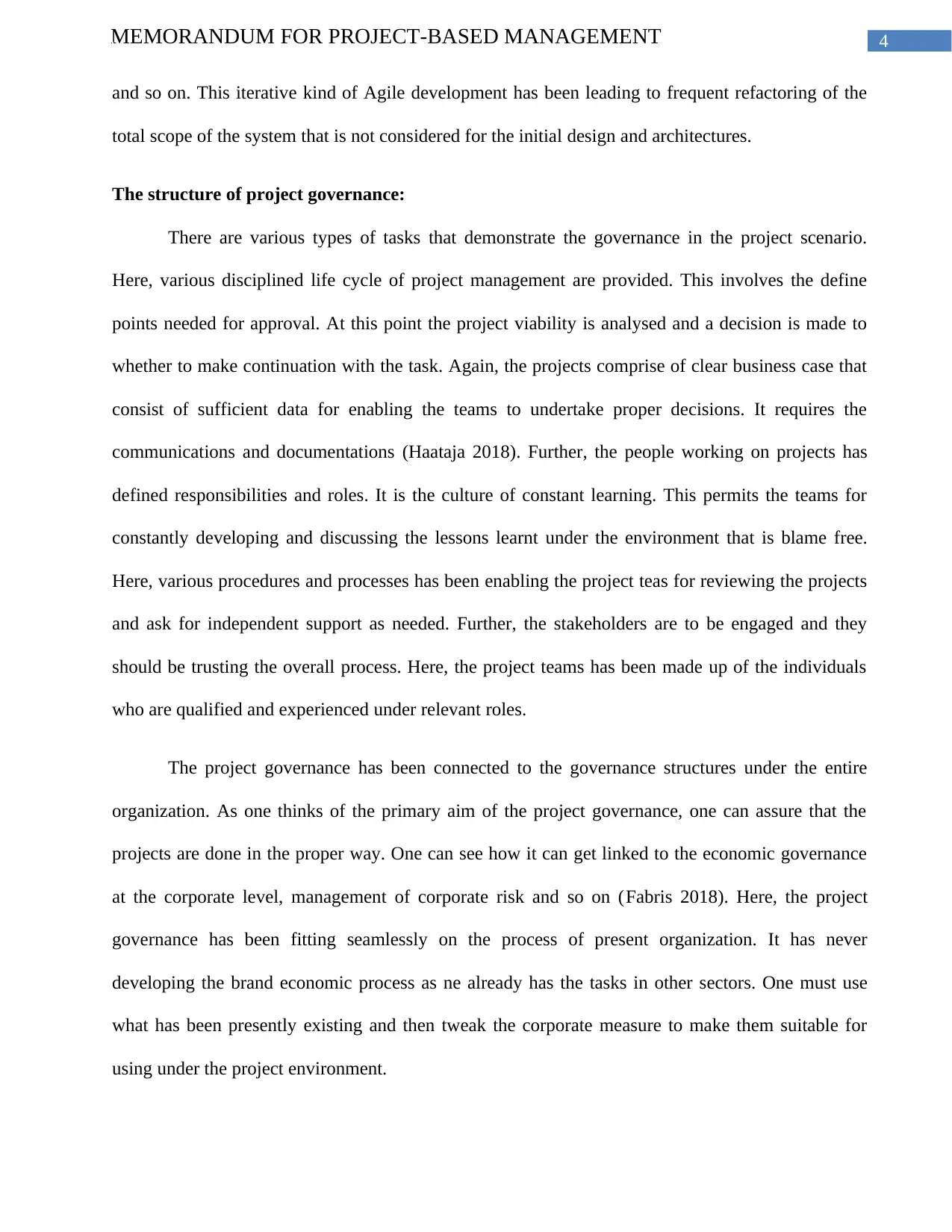
4MEMORANDUM FOR PROJECT-BASED MANAGEMENT
and so on. This iterative kind of Agile development has been leading to frequent refactoring of the
total scope of the system that is not considered for the initial design and architectures.
The structure of project governance:
There are various types of tasks that demonstrate the governance in the project scenario.
Here, various disciplined life cycle of project management are provided. This involves the define
points needed for approval. At this point the project viability is analysed and a decision is made to
whether to make continuation with the task. Again, the projects comprise of clear business case that
consist of sufficient data for enabling the teams to undertake proper decisions. It requires the
communications and documentations (Haataja 2018). Further, the people working on projects has
defined responsibilities and roles. It is the culture of constant learning. This permits the teams for
constantly developing and discussing the lessons learnt under the environment that is blame free.
Here, various procedures and processes has been enabling the project teas for reviewing the projects
and ask for independent support as needed. Further, the stakeholders are to be engaged and they
should be trusting the overall process. Here, the project teams has been made up of the individuals
who are qualified and experienced under relevant roles.
The project governance has been connected to the governance structures under the entire
organization. As one thinks of the primary aim of the project governance, one can assure that the
projects are done in the proper way. One can see how it can get linked to the economic governance
at the corporate level, management of corporate risk and so on (Fabris 2018). Here, the project
governance has been fitting seamlessly on the process of present organization. It has never
developing the brand economic process as ne already has the tasks in other sectors. One must use
what has been presently existing and then tweak the corporate measure to make them suitable for
using under the project environment.
and so on. This iterative kind of Agile development has been leading to frequent refactoring of the
total scope of the system that is not considered for the initial design and architectures.
The structure of project governance:
There are various types of tasks that demonstrate the governance in the project scenario.
Here, various disciplined life cycle of project management are provided. This involves the define
points needed for approval. At this point the project viability is analysed and a decision is made to
whether to make continuation with the task. Again, the projects comprise of clear business case that
consist of sufficient data for enabling the teams to undertake proper decisions. It requires the
communications and documentations (Haataja 2018). Further, the people working on projects has
defined responsibilities and roles. It is the culture of constant learning. This permits the teams for
constantly developing and discussing the lessons learnt under the environment that is blame free.
Here, various procedures and processes has been enabling the project teas for reviewing the projects
and ask for independent support as needed. Further, the stakeholders are to be engaged and they
should be trusting the overall process. Here, the project teams has been made up of the individuals
who are qualified and experienced under relevant roles.
The project governance has been connected to the governance structures under the entire
organization. As one thinks of the primary aim of the project governance, one can assure that the
projects are done in the proper way. One can see how it can get linked to the economic governance
at the corporate level, management of corporate risk and so on (Fabris 2018). Here, the project
governance has been fitting seamlessly on the process of present organization. It has never
developing the brand economic process as ne already has the tasks in other sectors. One must use
what has been presently existing and then tweak the corporate measure to make them suitable for
using under the project environment.
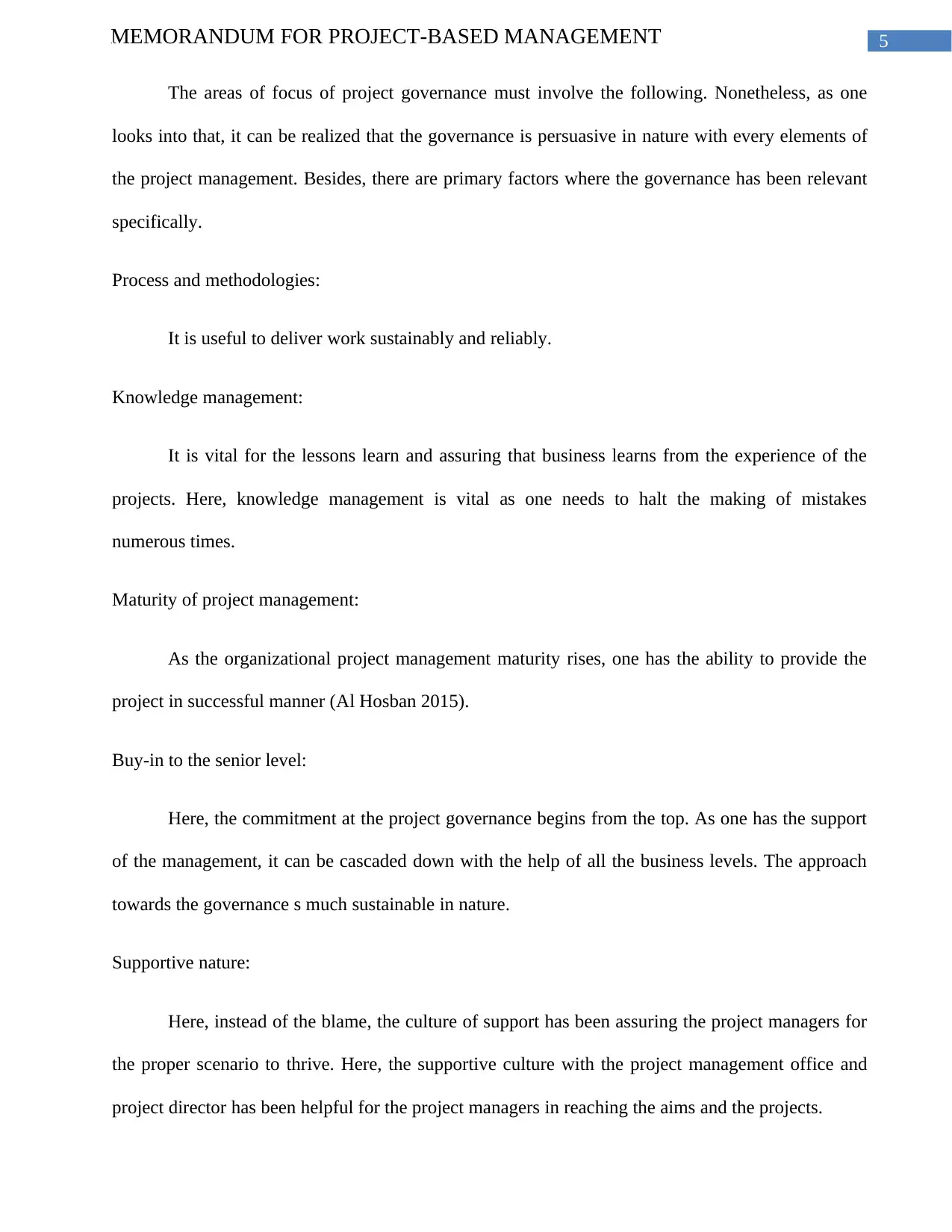
5MEMORANDUM FOR PROJECT-BASED MANAGEMENT
The areas of focus of project governance must involve the following. Nonetheless, as one
looks into that, it can be realized that the governance is persuasive in nature with every elements of
the project management. Besides, there are primary factors where the governance has been relevant
specifically.
Process and methodologies:
It is useful to deliver work sustainably and reliably.
Knowledge management:
It is vital for the lessons learn and assuring that business learns from the experience of the
projects. Here, knowledge management is vital as one needs to halt the making of mistakes
numerous times.
Maturity of project management:
As the organizational project management maturity rises, one has the ability to provide the
project in successful manner (Al Hosban 2015).
Buy-in to the senior level:
Here, the commitment at the project governance begins from the top. As one has the support
of the management, it can be cascaded down with the help of all the business levels. The approach
towards the governance s much sustainable in nature.
Supportive nature:
Here, instead of the blame, the culture of support has been assuring the project managers for
the proper scenario to thrive. Here, the supportive culture with the project management office and
project director has been helpful for the project managers in reaching the aims and the projects.
The areas of focus of project governance must involve the following. Nonetheless, as one
looks into that, it can be realized that the governance is persuasive in nature with every elements of
the project management. Besides, there are primary factors where the governance has been relevant
specifically.
Process and methodologies:
It is useful to deliver work sustainably and reliably.
Knowledge management:
It is vital for the lessons learn and assuring that business learns from the experience of the
projects. Here, knowledge management is vital as one needs to halt the making of mistakes
numerous times.
Maturity of project management:
As the organizational project management maturity rises, one has the ability to provide the
project in successful manner (Al Hosban 2015).
Buy-in to the senior level:
Here, the commitment at the project governance begins from the top. As one has the support
of the management, it can be cascaded down with the help of all the business levels. The approach
towards the governance s much sustainable in nature.
Supportive nature:
Here, instead of the blame, the culture of support has been assuring the project managers for
the proper scenario to thrive. Here, the supportive culture with the project management office and
project director has been helpful for the project managers in reaching the aims and the projects.
⊘ This is a preview!⊘
Do you want full access?
Subscribe today to unlock all pages.

Trusted by 1+ million students worldwide
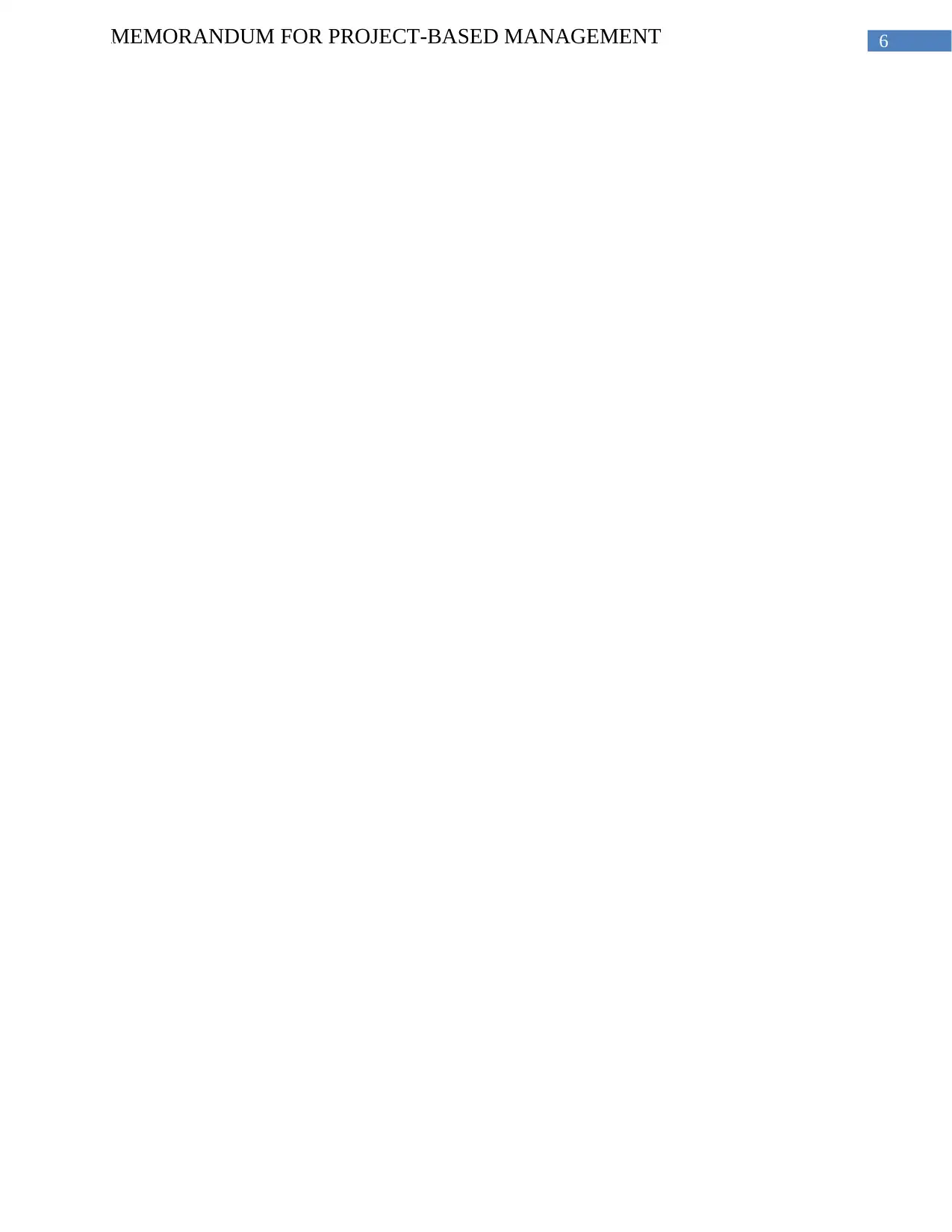
6MEMORANDUM FOR PROJECT-BASED MANAGEMENT
Paraphrase This Document
Need a fresh take? Get an instant paraphrase of this document with our AI Paraphraser
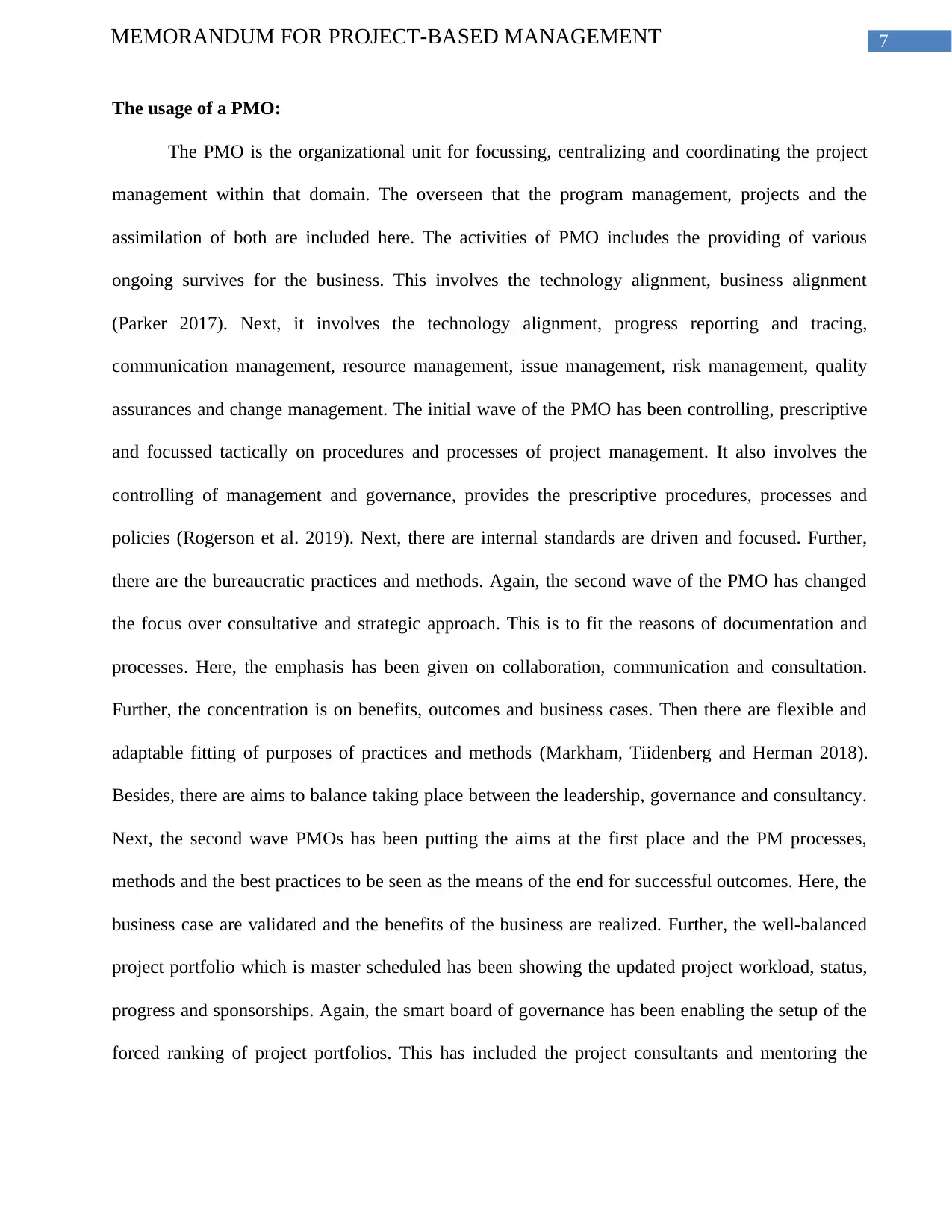
7MEMORANDUM FOR PROJECT-BASED MANAGEMENT
The usage of a PMO:
The PMO is the organizational unit for focussing, centralizing and coordinating the project
management within that domain. The overseen that the program management, projects and the
assimilation of both are included here. The activities of PMO includes the providing of various
ongoing survives for the business. This involves the technology alignment, business alignment
(Parker 2017). Next, it involves the technology alignment, progress reporting and tracing,
communication management, resource management, issue management, risk management, quality
assurances and change management. The initial wave of the PMO has been controlling, prescriptive
and focussed tactically on procedures and processes of project management. It also involves the
controlling of management and governance, provides the prescriptive procedures, processes and
policies (Rogerson et al. 2019). Next, there are internal standards are driven and focused. Further,
there are the bureaucratic practices and methods. Again, the second wave of the PMO has changed
the focus over consultative and strategic approach. This is to fit the reasons of documentation and
processes. Here, the emphasis has been given on collaboration, communication and consultation.
Further, the concentration is on benefits, outcomes and business cases. Then there are flexible and
adaptable fitting of purposes of practices and methods (Markham, Tiidenberg and Herman 2018).
Besides, there are aims to balance taking place between the leadership, governance and consultancy.
Next, the second wave PMOs has been putting the aims at the first place and the PM processes,
methods and the best practices to be seen as the means of the end for successful outcomes. Here, the
business case are validated and the benefits of the business are realized. Further, the well-balanced
project portfolio which is master scheduled has been showing the updated project workload, status,
progress and sponsorships. Again, the smart board of governance has been enabling the setup of the
forced ranking of project portfolios. This has included the project consultants and mentoring the
The usage of a PMO:
The PMO is the organizational unit for focussing, centralizing and coordinating the project
management within that domain. The overseen that the program management, projects and the
assimilation of both are included here. The activities of PMO includes the providing of various
ongoing survives for the business. This involves the technology alignment, business alignment
(Parker 2017). Next, it involves the technology alignment, progress reporting and tracing,
communication management, resource management, issue management, risk management, quality
assurances and change management. The initial wave of the PMO has been controlling, prescriptive
and focussed tactically on procedures and processes of project management. It also involves the
controlling of management and governance, provides the prescriptive procedures, processes and
policies (Rogerson et al. 2019). Next, there are internal standards are driven and focused. Further,
there are the bureaucratic practices and methods. Again, the second wave of the PMO has changed
the focus over consultative and strategic approach. This is to fit the reasons of documentation and
processes. Here, the emphasis has been given on collaboration, communication and consultation.
Further, the concentration is on benefits, outcomes and business cases. Then there are flexible and
adaptable fitting of purposes of practices and methods (Markham, Tiidenberg and Herman 2018).
Besides, there are aims to balance taking place between the leadership, governance and consultancy.
Next, the second wave PMOs has been putting the aims at the first place and the PM processes,
methods and the best practices to be seen as the means of the end for successful outcomes. Here, the
business case are validated and the benefits of the business are realized. Further, the well-balanced
project portfolio which is master scheduled has been showing the updated project workload, status,
progress and sponsorships. Again, the smart board of governance has been enabling the setup of the
forced ranking of project portfolios. This has included the project consultants and mentoring the
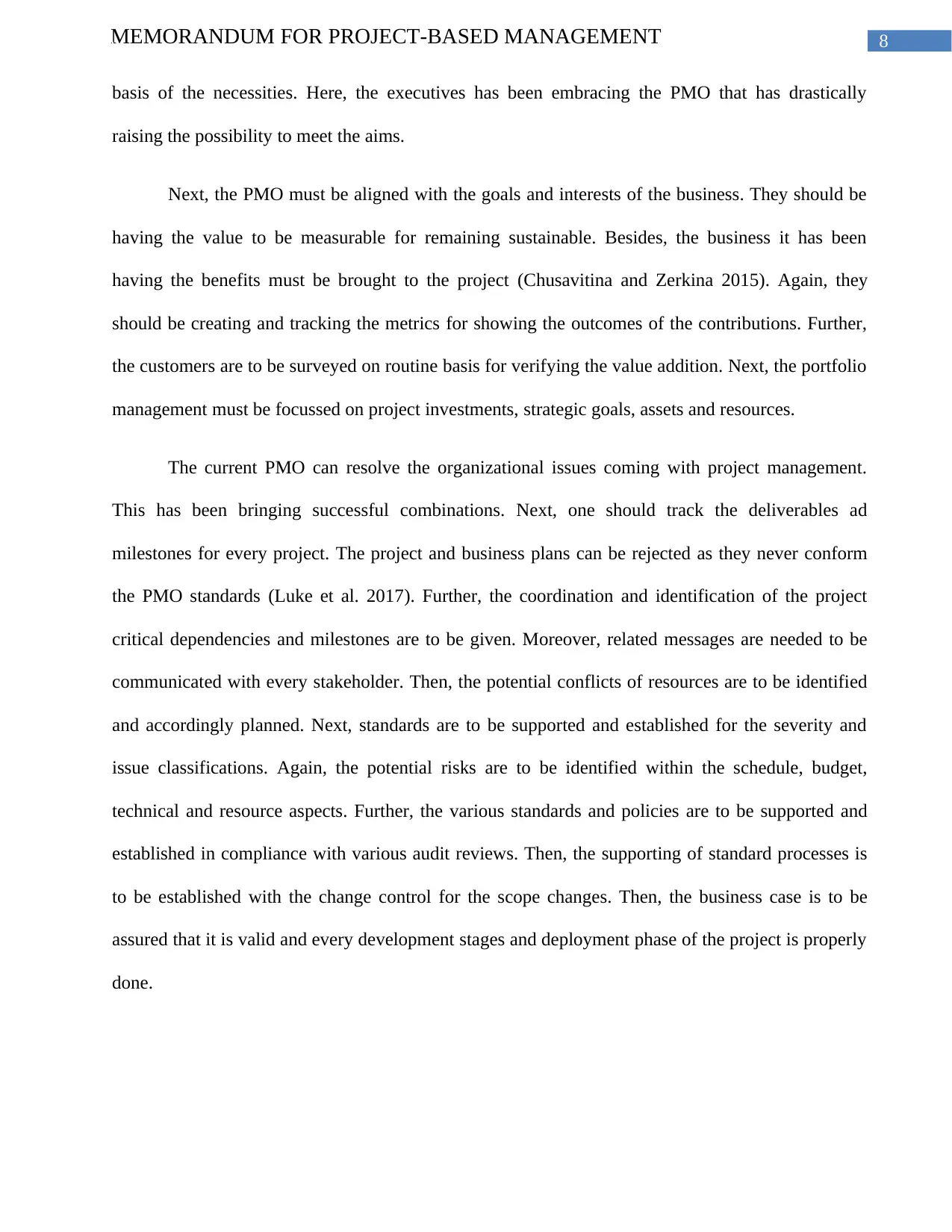
8MEMORANDUM FOR PROJECT-BASED MANAGEMENT
basis of the necessities. Here, the executives has been embracing the PMO that has drastically
raising the possibility to meet the aims.
Next, the PMO must be aligned with the goals and interests of the business. They should be
having the value to be measurable for remaining sustainable. Besides, the business it has been
having the benefits must be brought to the project (Chusavitina and Zerkina 2015). Again, they
should be creating and tracking the metrics for showing the outcomes of the contributions. Further,
the customers are to be surveyed on routine basis for verifying the value addition. Next, the portfolio
management must be focussed on project investments, strategic goals, assets and resources.
The current PMO can resolve the organizational issues coming with project management.
This has been bringing successful combinations. Next, one should track the deliverables ad
milestones for every project. The project and business plans can be rejected as they never conform
the PMO standards (Luke et al. 2017). Further, the coordination and identification of the project
critical dependencies and milestones are to be given. Moreover, related messages are needed to be
communicated with every stakeholder. Then, the potential conflicts of resources are to be identified
and accordingly planned. Next, standards are to be supported and established for the severity and
issue classifications. Again, the potential risks are to be identified within the schedule, budget,
technical and resource aspects. Further, the various standards and policies are to be supported and
established in compliance with various audit reviews. Then, the supporting of standard processes is
to be established with the change control for the scope changes. Then, the business case is to be
assured that it is valid and every development stages and deployment phase of the project is properly
done.
basis of the necessities. Here, the executives has been embracing the PMO that has drastically
raising the possibility to meet the aims.
Next, the PMO must be aligned with the goals and interests of the business. They should be
having the value to be measurable for remaining sustainable. Besides, the business it has been
having the benefits must be brought to the project (Chusavitina and Zerkina 2015). Again, they
should be creating and tracking the metrics for showing the outcomes of the contributions. Further,
the customers are to be surveyed on routine basis for verifying the value addition. Next, the portfolio
management must be focussed on project investments, strategic goals, assets and resources.
The current PMO can resolve the organizational issues coming with project management.
This has been bringing successful combinations. Next, one should track the deliverables ad
milestones for every project. The project and business plans can be rejected as they never conform
the PMO standards (Luke et al. 2017). Further, the coordination and identification of the project
critical dependencies and milestones are to be given. Moreover, related messages are needed to be
communicated with every stakeholder. Then, the potential conflicts of resources are to be identified
and accordingly planned. Next, standards are to be supported and established for the severity and
issue classifications. Again, the potential risks are to be identified within the schedule, budget,
technical and resource aspects. Further, the various standards and policies are to be supported and
established in compliance with various audit reviews. Then, the supporting of standard processes is
to be established with the change control for the scope changes. Then, the business case is to be
assured that it is valid and every development stages and deployment phase of the project is properly
done.
⊘ This is a preview!⊘
Do you want full access?
Subscribe today to unlock all pages.

Trusted by 1+ million students worldwide
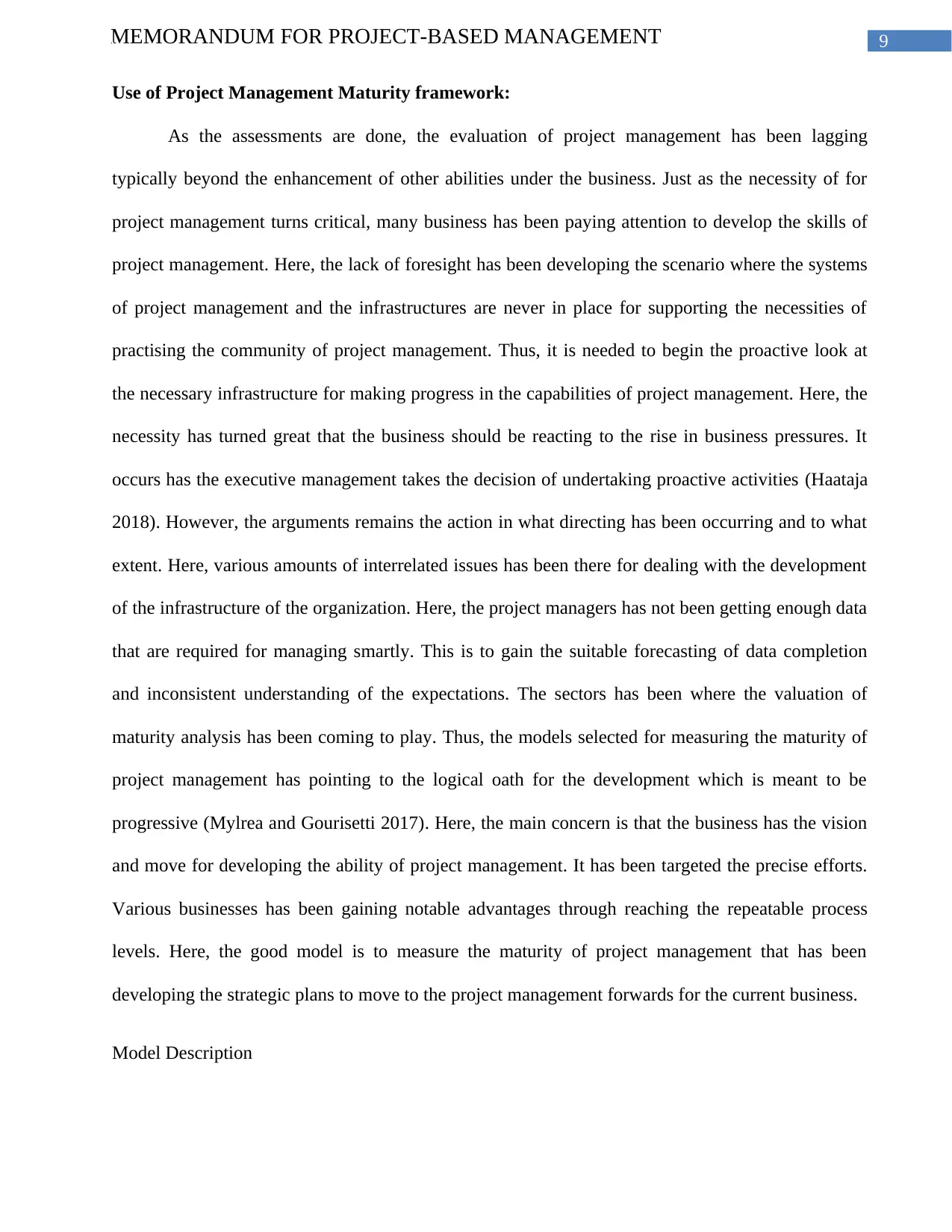
9MEMORANDUM FOR PROJECT-BASED MANAGEMENT
Use of Project Management Maturity framework:
As the assessments are done, the evaluation of project management has been lagging
typically beyond the enhancement of other abilities under the business. Just as the necessity of for
project management turns critical, many business has been paying attention to develop the skills of
project management. Here, the lack of foresight has been developing the scenario where the systems
of project management and the infrastructures are never in place for supporting the necessities of
practising the community of project management. Thus, it is needed to begin the proactive look at
the necessary infrastructure for making progress in the capabilities of project management. Here, the
necessity has turned great that the business should be reacting to the rise in business pressures. It
occurs has the executive management takes the decision of undertaking proactive activities (Haataja
2018). However, the arguments remains the action in what directing has been occurring and to what
extent. Here, various amounts of interrelated issues has been there for dealing with the development
of the infrastructure of the organization. Here, the project managers has not been getting enough data
that are required for managing smartly. This is to gain the suitable forecasting of data completion
and inconsistent understanding of the expectations. The sectors has been where the valuation of
maturity analysis has been coming to play. Thus, the models selected for measuring the maturity of
project management has pointing to the logical oath for the development which is meant to be
progressive (Mylrea and Gourisetti 2017). Here, the main concern is that the business has the vision
and move for developing the ability of project management. It has been targeted the precise efforts.
Various businesses has been gaining notable advantages through reaching the repeatable process
levels. Here, the good model is to measure the maturity of project management that has been
developing the strategic plans to move to the project management forwards for the current business.
Model Description
Use of Project Management Maturity framework:
As the assessments are done, the evaluation of project management has been lagging
typically beyond the enhancement of other abilities under the business. Just as the necessity of for
project management turns critical, many business has been paying attention to develop the skills of
project management. Here, the lack of foresight has been developing the scenario where the systems
of project management and the infrastructures are never in place for supporting the necessities of
practising the community of project management. Thus, it is needed to begin the proactive look at
the necessary infrastructure for making progress in the capabilities of project management. Here, the
necessity has turned great that the business should be reacting to the rise in business pressures. It
occurs has the executive management takes the decision of undertaking proactive activities (Haataja
2018). However, the arguments remains the action in what directing has been occurring and to what
extent. Here, various amounts of interrelated issues has been there for dealing with the development
of the infrastructure of the organization. Here, the project managers has not been getting enough data
that are required for managing smartly. This is to gain the suitable forecasting of data completion
and inconsistent understanding of the expectations. The sectors has been where the valuation of
maturity analysis has been coming to play. Thus, the models selected for measuring the maturity of
project management has pointing to the logical oath for the development which is meant to be
progressive (Mylrea and Gourisetti 2017). Here, the main concern is that the business has the vision
and move for developing the ability of project management. It has been targeted the precise efforts.
Various businesses has been gaining notable advantages through reaching the repeatable process
levels. Here, the good model is to measure the maturity of project management that has been
developing the strategic plans to move to the project management forwards for the current business.
Model Description
Paraphrase This Document
Need a fresh take? Get an instant paraphrase of this document with our AI Paraphraser
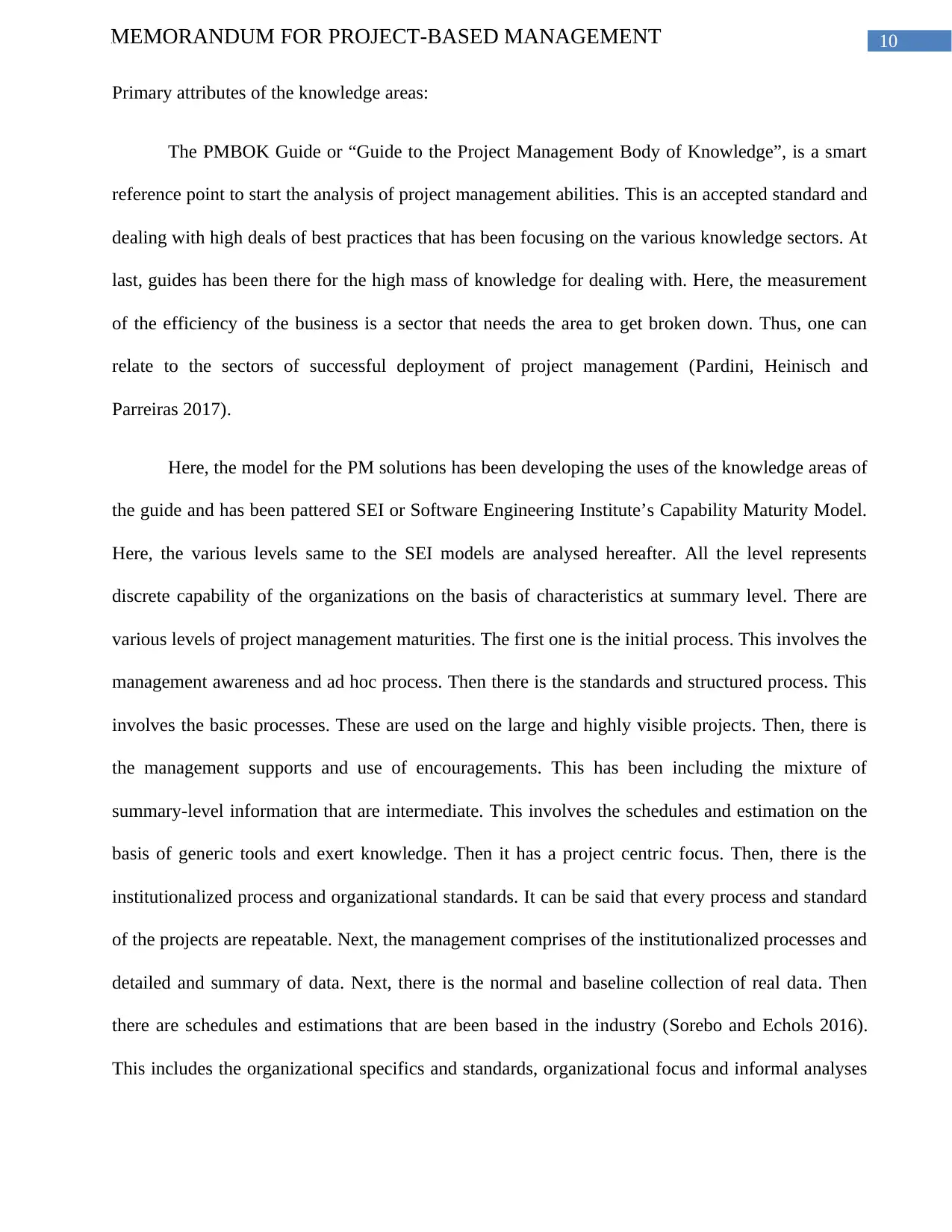
10MEMORANDUM FOR PROJECT-BASED MANAGEMENT
Primary attributes of the knowledge areas:
The PMBOK Guide or “Guide to the Project Management Body of Knowledge”, is a smart
reference point to start the analysis of project management abilities. This is an accepted standard and
dealing with high deals of best practices that has been focusing on the various knowledge sectors. At
last, guides has been there for the high mass of knowledge for dealing with. Here, the measurement
of the efficiency of the business is a sector that needs the area to get broken down. Thus, one can
relate to the sectors of successful deployment of project management (Pardini, Heinisch and
Parreiras 2017).
Here, the model for the PM solutions has been developing the uses of the knowledge areas of
the guide and has been pattered SEI or Software Engineering Institute’s Capability Maturity Model.
Here, the various levels same to the SEI models are analysed hereafter. All the level represents
discrete capability of the organizations on the basis of characteristics at summary level. There are
various levels of project management maturities. The first one is the initial process. This involves the
management awareness and ad hoc process. Then there is the standards and structured process. This
involves the basic processes. These are used on the large and highly visible projects. Then, there is
the management supports and use of encouragements. This has been including the mixture of
summary-level information that are intermediate. This involves the schedules and estimation on the
basis of generic tools and exert knowledge. Then it has a project centric focus. Then, there is the
institutionalized process and organizational standards. It can be said that every process and standard
of the projects are repeatable. Next, the management comprises of the institutionalized processes and
detailed and summary of data. Next, there is the normal and baseline collection of real data. Then
there are schedules and estimations that are been based in the industry (Sorebo and Echols 2016).
This includes the organizational specifics and standards, organizational focus and informal analyses
Primary attributes of the knowledge areas:
The PMBOK Guide or “Guide to the Project Management Body of Knowledge”, is a smart
reference point to start the analysis of project management abilities. This is an accepted standard and
dealing with high deals of best practices that has been focusing on the various knowledge sectors. At
last, guides has been there for the high mass of knowledge for dealing with. Here, the measurement
of the efficiency of the business is a sector that needs the area to get broken down. Thus, one can
relate to the sectors of successful deployment of project management (Pardini, Heinisch and
Parreiras 2017).
Here, the model for the PM solutions has been developing the uses of the knowledge areas of
the guide and has been pattered SEI or Software Engineering Institute’s Capability Maturity Model.
Here, the various levels same to the SEI models are analysed hereafter. All the level represents
discrete capability of the organizations on the basis of characteristics at summary level. There are
various levels of project management maturities. The first one is the initial process. This involves the
management awareness and ad hoc process. Then there is the standards and structured process. This
involves the basic processes. These are used on the large and highly visible projects. Then, there is
the management supports and use of encouragements. This has been including the mixture of
summary-level information that are intermediate. This involves the schedules and estimation on the
basis of generic tools and exert knowledge. Then it has a project centric focus. Then, there is the
institutionalized process and organizational standards. It can be said that every process and standard
of the projects are repeatable. Next, the management comprises of the institutionalized processes and
detailed and summary of data. Next, there is the normal and baseline collection of real data. Then
there are schedules and estimations that are been based in the industry (Sorebo and Echols 2016).
This includes the organizational specifics and standards, organizational focus and informal analyses
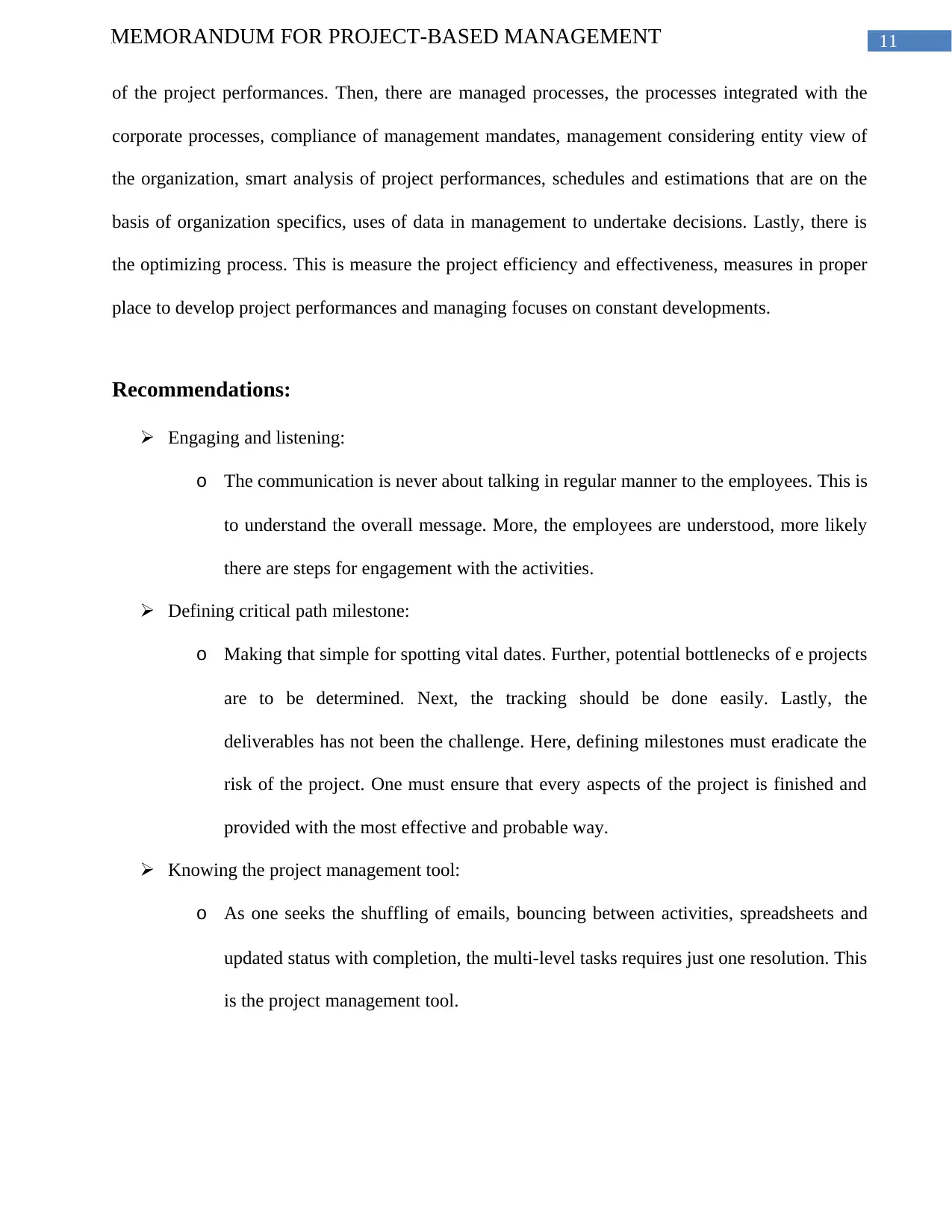
11MEMORANDUM FOR PROJECT-BASED MANAGEMENT
of the project performances. Then, there are managed processes, the processes integrated with the
corporate processes, compliance of management mandates, management considering entity view of
the organization, smart analysis of project performances, schedules and estimations that are on the
basis of organization specifics, uses of data in management to undertake decisions. Lastly, there is
the optimizing process. This is measure the project efficiency and effectiveness, measures in proper
place to develop project performances and managing focuses on constant developments.
Recommendations:
Engaging and listening:
o The communication is never about talking in regular manner to the employees. This is
to understand the overall message. More, the employees are understood, more likely
there are steps for engagement with the activities.
Defining critical path milestone:
o Making that simple for spotting vital dates. Further, potential bottlenecks of e projects
are to be determined. Next, the tracking should be done easily. Lastly, the
deliverables has not been the challenge. Here, defining milestones must eradicate the
risk of the project. One must ensure that every aspects of the project is finished and
provided with the most effective and probable way.
Knowing the project management tool:
o As one seeks the shuffling of emails, bouncing between activities, spreadsheets and
updated status with completion, the multi-level tasks requires just one resolution. This
is the project management tool.
of the project performances. Then, there are managed processes, the processes integrated with the
corporate processes, compliance of management mandates, management considering entity view of
the organization, smart analysis of project performances, schedules and estimations that are on the
basis of organization specifics, uses of data in management to undertake decisions. Lastly, there is
the optimizing process. This is measure the project efficiency and effectiveness, measures in proper
place to develop project performances and managing focuses on constant developments.
Recommendations:
Engaging and listening:
o The communication is never about talking in regular manner to the employees. This is
to understand the overall message. More, the employees are understood, more likely
there are steps for engagement with the activities.
Defining critical path milestone:
o Making that simple for spotting vital dates. Further, potential bottlenecks of e projects
are to be determined. Next, the tracking should be done easily. Lastly, the
deliverables has not been the challenge. Here, defining milestones must eradicate the
risk of the project. One must ensure that every aspects of the project is finished and
provided with the most effective and probable way.
Knowing the project management tool:
o As one seeks the shuffling of emails, bouncing between activities, spreadsheets and
updated status with completion, the multi-level tasks requires just one resolution. This
is the project management tool.
⊘ This is a preview!⊘
Do you want full access?
Subscribe today to unlock all pages.

Trusted by 1+ million students worldwide
1 out of 15
Related Documents
Your All-in-One AI-Powered Toolkit for Academic Success.
+13062052269
info@desklib.com
Available 24*7 on WhatsApp / Email
![[object Object]](/_next/static/media/star-bottom.7253800d.svg)
Unlock your academic potential
Copyright © 2020–2025 A2Z Services. All Rights Reserved. Developed and managed by ZUCOL.





